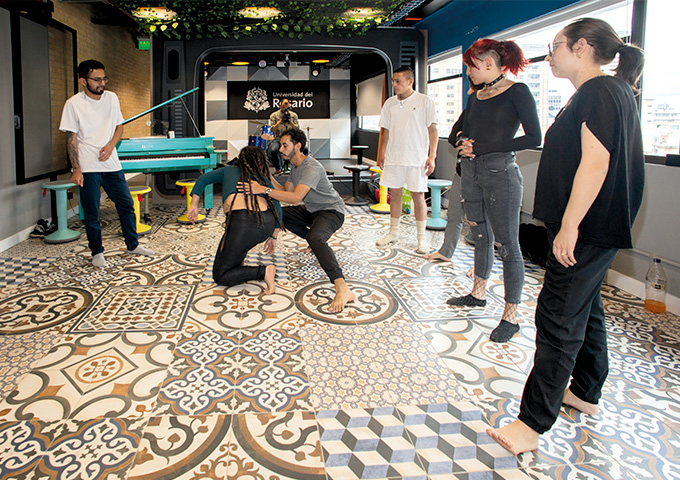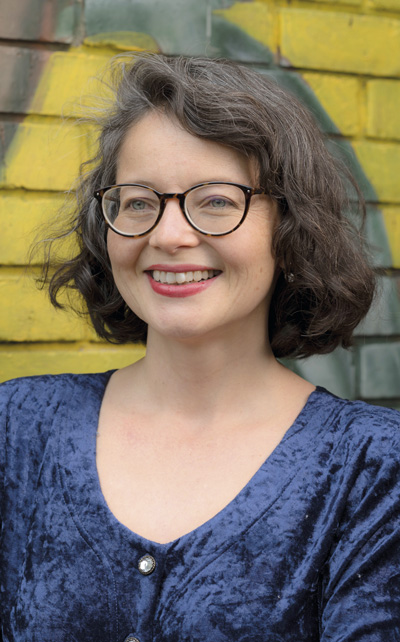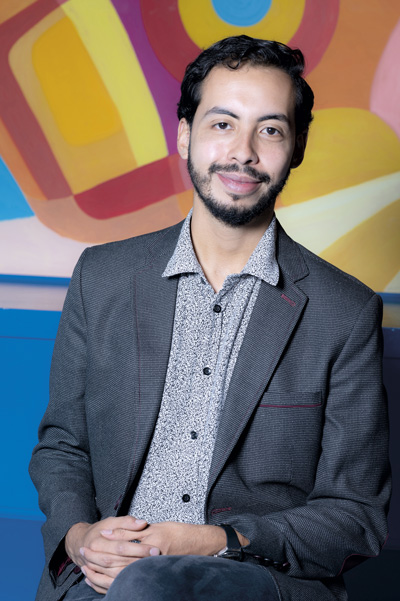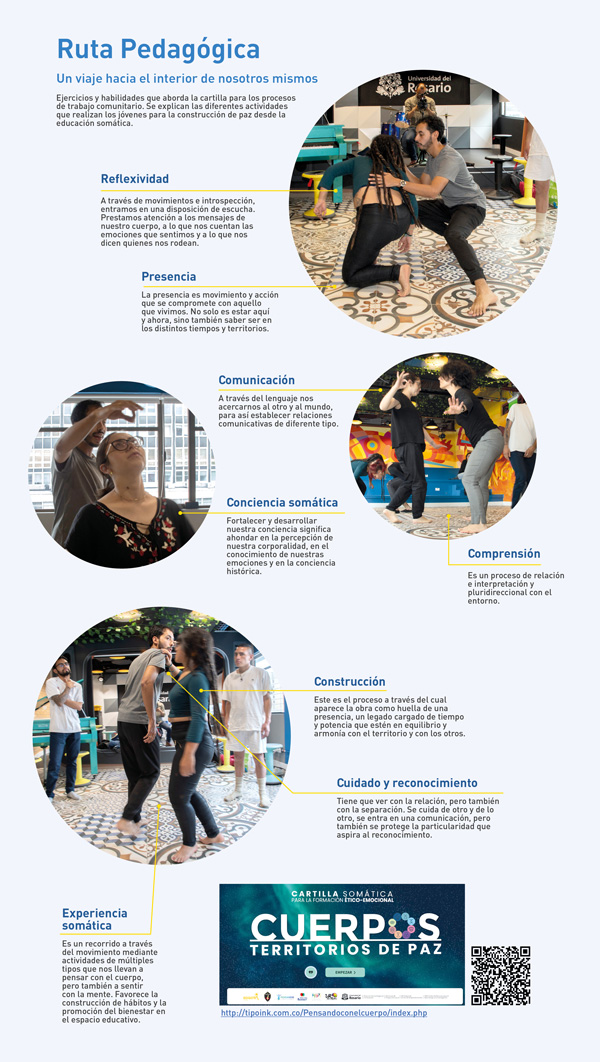“Bodies, places of peace” The language of movement and emotions as a conflicttransforming focal point
By: Ximena Serrano Gil
Photos: Milagro Castro
Society and Culture

By: Ximena Serrano Gil
Photos: Milagro Castro
I did know about the Universidad del Rosario since I used to hang out in the small square to sell marijuana to the preppy students who study there. But I never imagined that I would go there, much less as a student. This was the reflection expressed by a former street youth when they joined the Conflict for Peace, a space where young people from different places and with different realities come together to build and transform their relationships with themselves and society.
Today, Rosario students and young people affiliated with the Instituto Distrital para la Protección de la Niñez y la Juventud (District Institute for the Protection of Children and Youth [Idipron]) share and interact in trusting environments proposed for peacebuilding. There, they address different topics and content related to the transformation of conflicts that emerge in contexts of daily violence. The way to do this is through creative but non-violent dynamics and through the expression of the body and its movement, which is known as somatic perspective.
To talk about this innovative academic-social exercise and the approach of somatic education, the teachers and researchers of the project met on a cold and rainy morning in the warmth of a steaming and aromatic coffee.
With the enthusiasm, commitment, and knowledge that has driven them in designing this project, Beira Aguilar Rubiano, principal researcher and professor of the Philosophy Program of the School of Human Sciences at the Universidad del Rosario and the Center for Ethics and Citizenship Education Phronimos, Christian Rubiano Suza, coresearcher of Phronimos, and Lyner Bustos, Idipron co-researcher, explain the scope, impacts, and expectations of this pedagogical laboratory.
Body and movement for peace
To understand the world of somatics, Professor Christian Rubiano points out that “the first thing to understand is that we are not only a body with the skin as a limit, but we are a soma. The soma is the network of relationships that constitute us, which are broader than just the biological body. Therefore, we should not only take care of the body, but also of the relationships that sustain us.”
In turn, Professor Aguilar explains that the work in somatic education consists of “making us aware of this network of relationships that we inhabit, transforming and strengthening it through curative work.” One way to achieve this, the researcher continues, is through movement, through which emotions, citizenship training, and building places can be worked on.
Thus, since 2019, when the Phronimos Center and Idipron created the Conflict for Peace Chair within the framework of the management of social projects of the Office of Social Outreach and Alumni of the Universidad del Rosario, 150 students have had the opportunity to develop skills and strengthen project management. In this manner, through training and research exercises, they have been able to contribute to the transformation of their territories.
The realities of young people in cities are complex. They are mediated by injustices, structural inequalities, and various types of violence that determine social behavior and often interrupt people’s life projects. “The chair is a space that arose to make the children understand that, despite all they have lived through, there are still opportunities to transcend with their life stories,” says Idipron professor Lyner Bustos.
The concept of peace proposed by the project does not focus on the armed conflict since Bogotá does not have a strong recruitment or forced displacement process. Instead, it is a concept of everyday peace based on the fact that the rhythms of the street, the problems between neighbors, the invisible borders between neighborhoods, and the emotional confrontation between family members are the breeding ground for the different forms of violence experienced by these young people in their daily lives.
One of these creative windows for the solution and intervention of everyday conflicts is the top Pedagogical Route (Video) created in the project framework Thinking about the Body, thanks to which practices and spaces of care are constructed through somatic education and emotional management.

Professor Beira Aguilar, principal researcher of the project, explains that the work in somatic education consists of “making us aware of the network of relationships we inhabit, transforming and strengthening it through collaborative work. One way to achieve this is through movement, by means of which we can work on emotions, citizenship training and constructing territories.”
Based on these pedagogical models, the interdisciplinary team directed the training toward citizenship to enhance its scope. Then, there was a proposal to create a participatory and co-creation mechanism with young people to transfer knowledge and experiences of this pedagogical route. This is how the Interactive Primer Bodies, Territories of Peace was born, with the support of the Technological Innovation Fund of Universidad del Rosario.
This booklet is a resource to teach the different pedagogical actions, exercises, and skills. It proposes a transformative journey through the development of eight competencies: reflexivity, communication, somatic awareness, compression, presence, construction, care and recognition, and somatic experience. The aim is for people to reflect and deepen their self-knowledge from their own emotions, movements, and thoughts in relation to their life in community and the territories they inhabit.
The teachers emphasize that the booklet is the result of collaborative work between the young people affiliated with Idipron and the students of the University. For his part, Rubiano expresses that “our purpose is to develop an interactive and virtual booklet that promotes peacebuilding from a somatic perspective. Its development has been the result of the workshops to create peace, as well as a process of accompaniment and digital construction with the assistance of the Learning and Research Resources Center (CRAI by its acronym in Spanish).”
The completion of this educational prototype will be delivered to the population at the end of this year and will become a free access resource that seeks to strengthen the processes of territorial peacebuilding in Idipron. “A booklet is a tool for the work that young people do in their territories and it promotes the use of this knowledge as a strategy for conflict resolution,” explains professor Aguilar.

To understand the world of somatics, Christian Rubiano, co-researcher of Phronimos at the URosario, states that “the first thing to understand is that we are not only a body whose limit is the skin, but we are a soma; and the soma is the network of relationships that form us, which are broader than just the biological body. Hence, we should not only take care of the body, but also of the relationships that sustain us.”
The District Institute for the Protection of Children and Youth (Idipron) is an agency of the Mayor’s Office of Bogota that seeks to build a project and a sense of life for children, adolescents, and young people living on the streets at risk of living on the streets or in conditions of social fragility in the city.
Building an Environment of Trust
The anticipated course has been a stage for meetings and collaboration where work is done through activities such as yoga, dance, theatrical games, and design thinking methodologies. “We don’t want to give them a particular teaching, but rather that everyone, in a reflective process, finds or proposes activities based on their experience and knowledge; something that represents them and helps them to enhance the process of creating daily peace, through the management of emotions and body awareness,” Rubiano argues.
Approximately 150 students have participated in the course so far, thanks to the collaboration between a public organization, which seeks to guarantee the rights of young people, and the Universidad del Rosario, which, with an innovative pedagogical model, helps to generate new processes of transformation for peace. These participants will become multipliers and transformers who will disseminate what they have learned in these processes throughout the city. The first beneficiaries of the course today are linked to jobs in which individuals have the opportunity to apply what they have learned in their training. Some, for example, are teachers at Idipron, while others work at the District Institute of Recreation and Sports (IDRD).
This project provides an important opportunity for all those who participate in it. For Idipron, it becomes a tool to better understand the peacebuilding processes in different territorial spaces. For the academic areas involved, it provides a space to strengthen training models; for the University, it offers a significant contribution to its commitment to peacebuilding.
